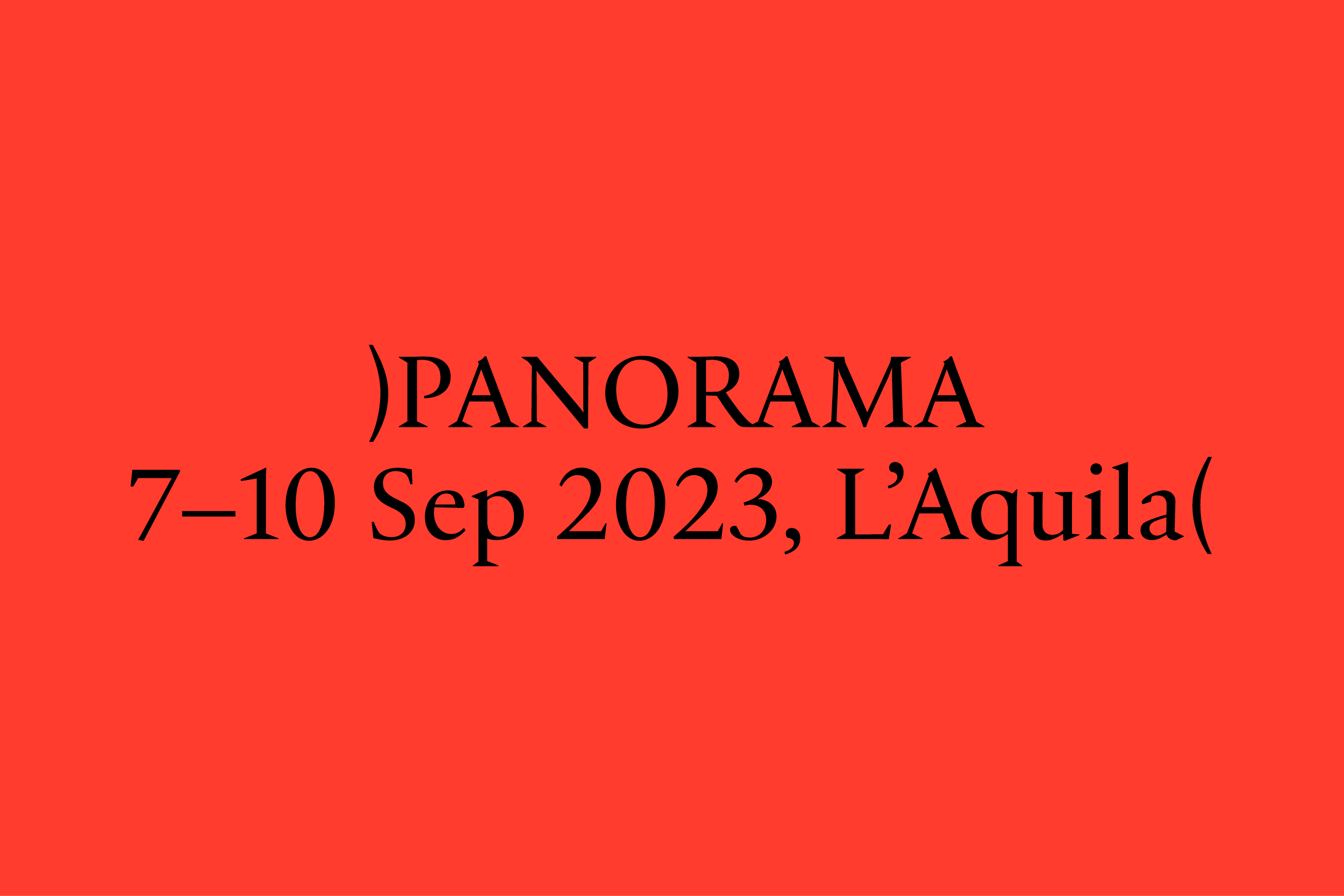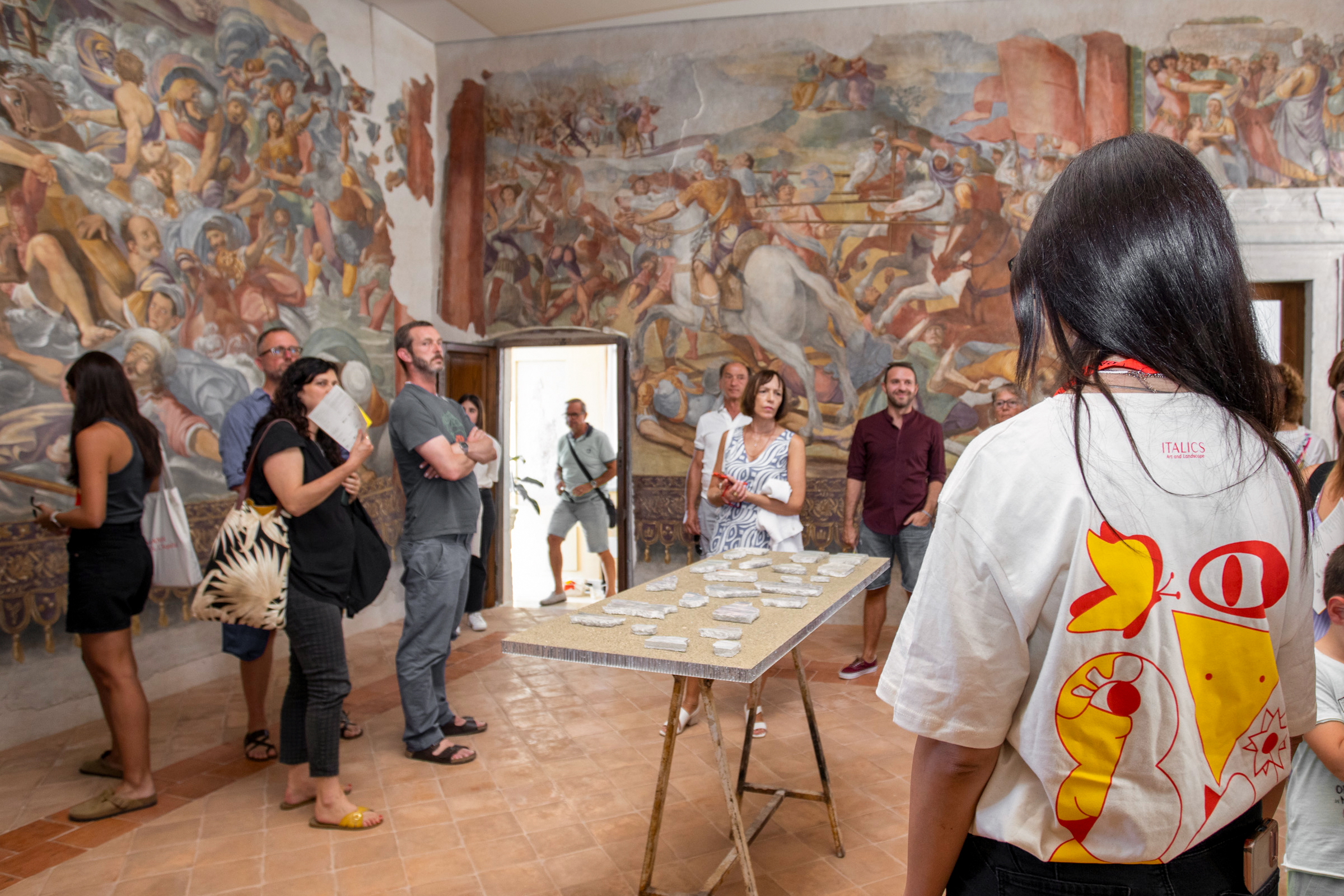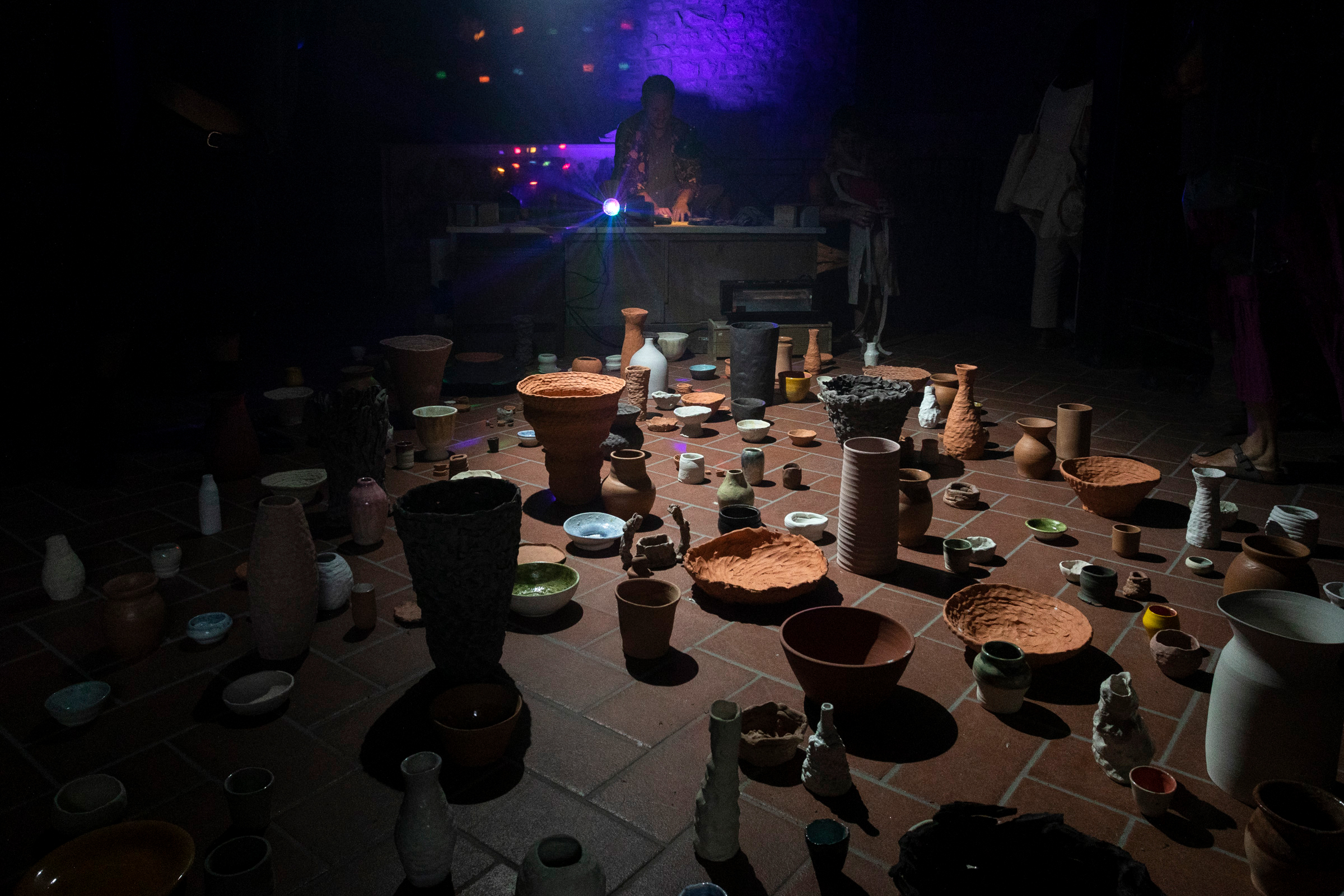
A city-wide exhibition curated by Cristiana Perrella
7 – 10 September 2023
After Procida and Monopoli, ITALICS brought the third edition of Panorama to L’Aquila. Since 2021, this multi-site traveling exhibition has been forging connections between art, architecture, antiquity and the contemporary, and the territory and its communities.

Sunday 10 September was the closing of the highly successful Panorama L’Aquila, the third edition of the city-wide art exhibition conceived by ITALICS – the first institutional network of art galleries to be established in Italy. Every year, in some of the most unique locations in our country, it brings art, architecture, antiquity and the contemporary together, involving the territory and its communities.
Curated by Cristiana Perrella, the exhibition had the capital of Abruzzo buzzing with life for 4 days – from 7 to 10 September – when art, cinema, performances and meetings with the public took place with great enthusiasm and involvement on the part of the participants. Some 13,000 people crowded the city streets – most of them in L’Aquila for the first time – bent on seeing every one of the 20 exhibition venues, the 60 artists, the 100 and more works of art, the series of 10 performances but also the cafes with the artists, the talks and the film screenings.
In an itinerary that has involved museums and aristocratic palaces but also bakeries, bookstores, record stores, restoration workshops and private homes, – from the Caffè Fratelli Nurzia to the Casino delle Delizie Branconio, the Museo Nazionale di Abruzzo | Castello Cinquecentesco, Palazzo Rivera and MAXXI L’Aquila – to the sky above the city, Panorama made the city the full-blown protagonist of the event, tracing out a composite portrait consisting of both its monumental historic features and the industriousness of daily life. In all of this, alongside the wound inflicted by the 2009 earthquake, the energy of reconstruction is clearly visible.

Taking its cue from the term wit(h)nessing, coined by the feminist theorist, artist and psychoanalyst Bracha L. Ettinger, which extends the concept of witnessing from the individual to the collective and participatory dimension, Panorama L’Aquilahas put together an itinerary made up of places – not simple “containers” but generators of content inhabited by works that can give the public a new image of the city, a portrait drawn from its historical and monumental features and its daily industriousness.
The kaleidoscopic festival presented over 100 works, including paintings, sculptures, installations, performances and site-specific works, realized between 1300 and 2023 and made by more than 60 artists, Italian and foreign, from the great names in Art History to established, mid-career or up-and-coming artists, and of course many artists from the local area such as Lucia Cantò, Gianni Caravaggio, Alberto Di Fabio, Ettore Spalletti, and Giuseppe Stampone.

The program of Panorama L’Aquila was structured around two large exhibition centers generously hosted by the private residence of Palazzo Nardis and the extraordinary construction site of Palazzo Rivera. There, thanks to a selection of works dedicated to political, social and gender issues, a dialogue between different eras in the History of Art was initiated. At the Museo Nazionale d’Abruzzo | Castello Cinquecentesco, a military fortification in Parco del Castello, the Sala del Mammut hosted the documentation of a performance by Radha D’Souza & Jonas Staal next to the monumental relic of the gigantic prehistoric mammoth. On the access bridge, a flag, the work of Gianni Caravaggio, waved for four days and was then left as a donation for the MuNDA.
On Largo Tunisia, immediately after the Fontana Luminosa, the mosaic created by Alberto Di Fabio, a work of public art installed on a wall, was donated to the city as a commemorative reminder of the event.
At the Oratory of Sant’Antonio dei Cavalieri de Nardis, Massimo Bartolini’s installation became site-specific as a result of its relationship with the playing of the Oratory’s monumental organ for the collaboration in the event Jazz italiano per le terre del sisma and the third edition of Performative03, a MAXXI L’Aquila project dedicated to performance and dance. For Panorama, the L’Aquila branch of the Museo nazionale delle arti del XXI secolo also hosted two works by Paolo Icaro in the courtyard, while in the Project Room, Haim Steinbach’s display hosted works by Alberto Burri, Michele Cammarano and Steinbach himself.



2023. Courtesy the artist and Galleria Lia Rumma



The Fondazione Giorgio de Marchis Bonanni D’Ocre Onlus welcomed a focus panel that, starting with the research on futurism by art historian Giorgio De Marchis, explored the work of Giacomo Balla and Fabio Mauri, through archive materialfrom the collections of Giancarlo Gentilucci Arti e Spettacolo Impresa Sociale, MUSPAC – Museo Sperimentale d’Arte Contemporanea, the Galleria Nazionale d’Arte Moderna e Contemporanea di Roma and the Foundation itself.
Santa Margherita in Forcella hosted a tribute to the artist Ettore Spalletti, while at the Corte dei Conti, the landscape that can be seen from the cloister of the Complesso Monumentale di San Domenico interacted with Pascale Marthine Tayou’s large work in crystal, created for the occasion and set up in the center of the courtyard. Very importantly, the Casino delle Delizie Branconio was reopened, thanks to the willingness of its owners, and a work by Anri Sala found its place among the frescoes of the School of Raphael Sanzio.
There was no lack of symbolic acts and political gestures that challenged the classic exhibition model, starting with the involvement of historic shops or new businesses: from the famous Caffè Fratelli Nurzia, which hosted Alek O.’s work, to the local Førma Bakery where it was possible to buy bread by Luca Trevisani. The Palazzo della Cassa di Risparmio and small businesses such as the Sound Garden record shop, the Stile Novecento furniture restoration shop, and the Polarville bookshop were also involved, and finally, the city sky crossed by Maurizio Nannucci’s aerial banner that invited the public and L’Aquila’s citizens to talk about art for the entire duration of the event.
There was plenty of public participation in the performance art events: Jacopo Benassi in collaboration with the Casella Conservatory invaded the cloister of Palazzo Cappa Cappelli with his sound performance; Palazzetto dei Nobili, the ancient center of L’Aquila’s political life, with Chiara Camoni and the Centro di Sperimentazione, was transformed into a place where artisan practices were highlighted by the power of music and dance; the deconsecrated church that was once the studio of L’Aquila painter Marcello Mariani reopened forthisoccasion,hosting the musical performance by Darren Bader.




Special initiatives included the third edition of the Italics d’Oro – an award that every year celebrates the intense bond between an artist and their territory – and this year was awarded to Ugo La Pietra (Bussi sul Tirino – Pescara, 1938). An artist, architect and designer, a tireless investigator of the relationship between the individual and the environment, La Pietra has always critically and unorthodoxly supported the humanistic, signifying and territorial component of art and design. The relationship between art and urban space has always been at the center of his work, and for this reason, in a city like L’Aquila, which is being reborn and reimagined, it seemed particularly meaningful to present him with this award. It recognizes the value of his practice and thought and their generative capacity in the context of a reflection on the reappropriation of public and private living spaces.
Ad Minoliti, Argentine-born artists known internationally for their metaphysical abstractions aimed at dismantling modernist utopia and its most reprehensible and patriarchal aspects, were among the participants in the city-wide exhibition and designed a special project dedicated to Panorama L’Aquila and its visitors. In fact, their drawings, specially made for this occasion, appeared on the tote bags and T-shirts of the cultural mediators and guides who took the public on a tour of the exhibition.
















The days of the festival included a packed Public Program with a series of events: important and rare art films such as Ugo La Pietra’s La riappropriazione della città, JR and Alice Rohrwacher’s Omelia contadina, Matteo Parisini’s L’universo di Luigi Ghirri, Wim Wenders’ Anselm and Alessandra Galletta’s Ettore Spalletti were screened every evening at the Auditorium del Parco with At the Cinema; two cafes in the historic center hosted the sessions of A coffee with the Artists, where the public had the chance to meet and discuss art (and more) with the many artists in the city; the Book Corner featured publications selected by the curator, while the talk Why is there so much art in Abruzzo? described the vibrant regional artistic scene.











“Dialogue in diversity is the most fascinating element of Panorama,” stated Cristiana Perrella. “The challenge was to bring works, places, people, knowledge, history into relation with the contemporary, the everyday and the monumental, and through this multiplication of viewpoints, united by a single project, to generate a new vision of a place. L’Aquila was the perfect city for such an event because it is full of stories to be told, things to discover, very different and often unexpected.”



A uniqueexhibition experience, Panorama L’Aquila has been able to perfectly epitomize the values of ITALICS. It has brought together the ancient, modern and contemporary, multiple styles, techniques and thoughts in art itineraries that led to the discovery of the most authentic and lesser-known aspects of our country, continuing the extraordinary journey begun in 2020 in the web pages of the Italics.art platform. A format desired and shared by the consortium of galleries in a collaborative effort with the territories, Panorama is symbolic of a commitment to expand steadily with a program and alliances that reaffirm the importance and role of art galleries in an ever-evolving cultural, local and global system.

Artists
Carlo Albacini, Eleanor Antin, Darren Bader, Giacomo Balla, Yael Bartana, Massimo Bartolini, Jacopo Benassi, Cristiano Bianchin, Ambrogio Borghi, Alberto Burri, Gasparo Cairano, Michele Cammarano, Chiara Camoni, Lucia Cantò, Mircea Cantor, Gianni Caravaggio, Stefania Carlotti, Vincenzo Castellini, Marie Cool Fabio Balducci, Joan Crous, Enzo Cucchi, Radha D’Souza & Jonas Staal, Alberto Di Fabio, Lucio Fontana, Christian Frosi, Piero Golia, Diego Gualandris, Shadi Harouni, Paolo Icaro, Emily Jacir, Chantal Joffe, Luisa Lambri, Armin Linke, Christiane Löhr, Beatrice Marchi, Nicola Martini, Master of the Madonna in the Cathedral of Spoleto, Fabio Mauri, Mario Merz, Ad Minoliti, Davide Monaldi, Giorgio Morandi, Maurizio Nannucci, Neapolitan Sculptor (circle of Luca Giordano), Nunzio, Alek O., Nicola Pecoraro, Diego Perrone, Robin Rhode, Carl Borromäus Andreas Ruthart, Anri Sala, Vincenzo Schillaci, Ettore Spalletti, Giuseppe Stampone, Haim Steinbach, Pascale Marthine Tayou, Marco Tirelli, Luca Trevisani, Tatiana Trouvé, Alessandro Varotari, known as il Padovanino.
Panorama L’Aquila was made possible through the support of the Municipality of L’Aquila and under the patronage of UNESCO and the Ministry of Culture, and with the support of Belmond as main partner.
This was the second year that Belmond participated as a main partner in support of ITALICS activities. Its commitment to Italy and the arts community goes beyond hospitality and its properties. The continuation of the partnership further reinforces the common goal of promoting Italy and its territory through art, inviting the public to see the country’s culture and beauty from a unique and original point of view.
The media partnership with Il Giornale dell’Arte also continues, joined by a partnership with Sky Arte.
The collaboration with Treccani Arte x Panorama was again renewed as well. With Treccani Arte x Panorama, the exhibition’s key concepts were chronicled on social networks through Dictionary definitions.
For their collaboration, we thank Arti e Spettacolo Impresa Sociale, Fondazione Giorgio de Marchis Bonanni D’Ocre Onlus, MAXXI L’Aquila, MuNDA Museo Nazionale d’Abruzzo, MUSPAC, Studio Fabio Mauri, and for special participation Accademia di Belle Arti L’Aquila, Conservatorio Statale di Musica “Alfredo Casella,” Convitto Nazionale “D. Cotugno” with Licei Annessi and Førma Bakery.
Our heartfelt thanks also go to the General Directorate of Museums of the Ministry of Culture, in the person of Director Massimo Osanna, to the Superintendence of Archaeology, Fine Arts and Landscape for the provinces of L’Aquila and Teramo, in the person of Superintendent Cristina Collettini, to the Municipality of L’Aquila and in particular the AQ Sector Projects for Rebirth, and to MuNDA, in the person of Deputy Director Federica Zalabra.
For support in the cultural mediation project, we thank the FAI Delegation of L’Aquila and the Jemo ‘nnanzi Association.
We thank the BPER Banca for granting use of the outdoor spaces of the historic building on Corso Vittorio Emanuele.
We also thank Forma Edizioni and Masciarelli Tenute Agricole for their technical sponsorships.
Special thanks go to Bartolomeo Pietromarchi and all those who welcomed Panorama into their spaces and made the event possible with their contributions, in particular, Giovanna Cennicola, Eugenia D’Aurelio, Marianna D’Ovidio, the tenants of Palazzo Micheletti, Giancarlo Gentilucci, the Nardis family, Fratelli Navarra, Valeria Pica, Vincenzo Rivera, and Maria Luisa Vicentini.













Photo Credits: Alessio Tamborini and Luca M. Fontana
Participating galleries
ADA; Galerie Rolando Anselmi; Alfonso Artiaco; Bacarelli; Galleria Alessandro Bagnai; Bottegantica; Botticelli Antichità; Galleria Canesso; Cardi Gallery; Alessandro Cesati; Clima; Galleria Continua; Galleria Raffaella Cortese; Thomas Dane Gallery; Massimo De Carlo; Galleria Tiziana Di Caro; Alessandra Di Castro; Galleria Umberto Di Marino; Ermes Ermes; Federica Schiavo Gallery; Galleria Fonti; Galleria Fumagalli; Gagosian; Galleria dello Scudo; Giacometti Old Master Paintings; kaufmann repetto; Laveronica Arte Contemporanea; Galleria Lia Rumma; Magazzino; Martina Simeti; Mazzoleni, London-Torino; Francesca Minini; Galleria Massimo Minini; Monitor; Maurizio Nobile Fine Art; Galleria Franco Noero; Galleria Carlo Orsi; P420; Peola Simondi; Peres Projects; Giorgio Persano; Pinksummer; Porcini; Prometeo Gallery Ida Pisani; Richard Saltoun Gallery; SpazioA; Studio Sales di Norberto Ruggeri; Studio Trisorio; Caterina Tognon Arte Contemporanea; Tornabuoni Arte; Tucci Russo Studio per l’Arte Contemporanea; Federico Vavassori; Victoria Miro Venice; Galleria Carlo Virgilio & C.; Vistamare; ZERO…
Panorama L’Aquila
Downloads
The Exhibition guide
The Agenda
The Map
Panorama Off, places of culture and landscape, exhibitions and events beyond Panorama L’Aquila
With the support and under the patronage of

Under the Patronage of


Main Partner

Media Partner



In collaboration with






With the special participation of





Events technical sponsor

Technical sponsor

Follow us
Stay updated on Panorama L’Aquila with the ITALICS newsletter
Follow on Instagram @italics.art and the hashtag #PanoramaLAquila